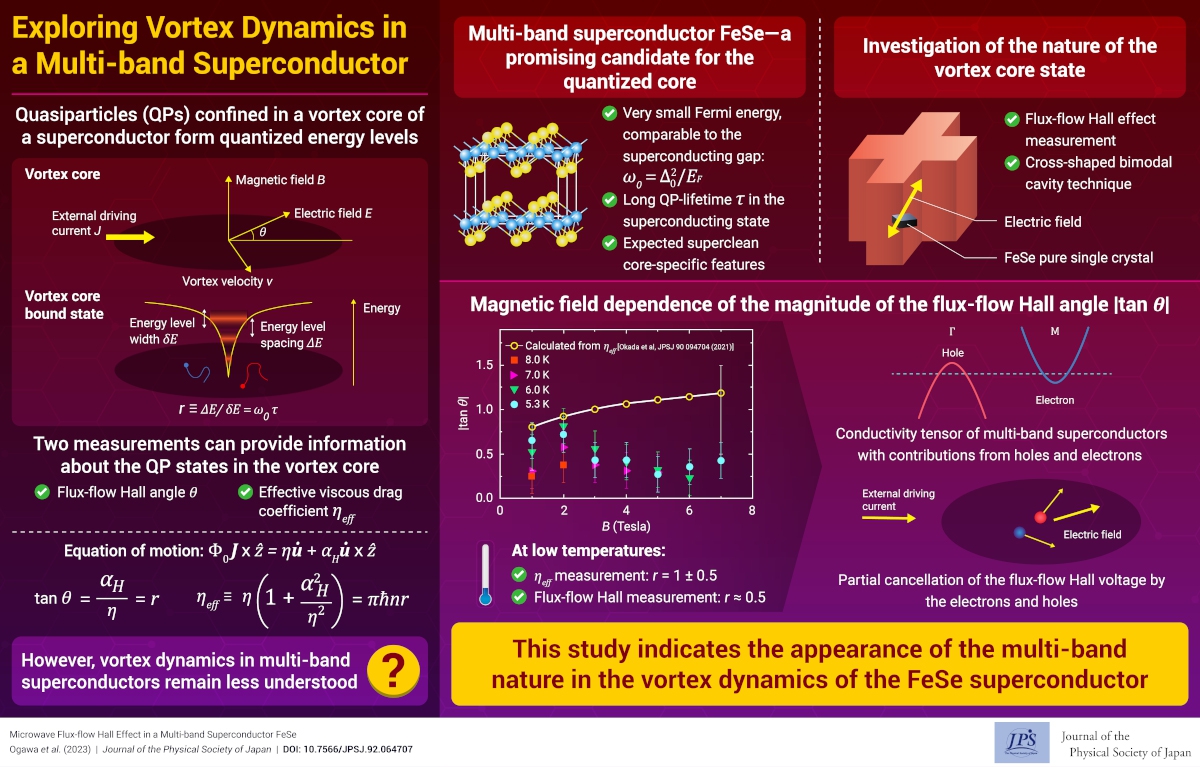Exploring Vortex Dynamics in a Multi-band Superconductor
© The Physical Society of Japan
This article is on
J. Phys. Soc. Jpn.
92,
064707
(2023)
.
We measured the microwave flux-flow Hall effect in FeSe, where the cancellation of holes and electrons was observed. This is a novel effect of multi-band superconductors.

In type II superconductors under a magnetic field, the magnetic field penetrates as a quantized flux accompanied by the surrounding rotating currents (magnetic vortex). Because the motion of vortices dominates the electromagnetic behavior of superconductors, understanding their kinetics and dynamics is extremely important from scientific and application perspectives. In fact, the kinetics of vortices, flux flow, has been the subject of extensive long-term experimental and theoretical studies. However, our understanding of flux flow, even at the fundamental level, was far from satisfactory until recently. The key component of this problem is the electronic structure of the central part of the vortex (core), where quantized levels of non-superconducting carriers (quasiparticles) are formed. In most superconductors, the quantized nature is almost invisible because of the quantized level spread (dirty limit), which generates ordinary longitudinal flux-flow resistivity. On the other hand, for vortices with clean cores, where the aforementioned quantized nature is prominent, we expect a large Hall effect with a Hall angle of almost π/2. Thus, direct measurement of the Hall angle by the flux flow provides important fundamental information about the kinetics of the vortices. In particular, the study of materials with clean-core vortices is promising, as novel quantum effects are expected.
To experimentally discuss the flux flow, we need to work at high frequencies and low temperatures. However, the Hall effect measurement in microwaves, for instance, in cryogenic circumstances for highly conductive materials, is challenging. We recently developed a cross-shaped bimodal cavity technique to measure the microwave Hall effect in highly conductive materials and observed a large Hall angle of vortex motion in high-Tc cuprate superconductors, in which we expected the quantized nature of the core to be visible. Although our results are surprising and puzzling compared to those of previous flux-flow studies, which used a simpler longitudinal resistivity measurement (effective viscous drag coefficient measurement), it is extremely exciting to see if such a large flux-flow Hall angle is observed in other superconductors that are expected to have a clean vortex core.
In this study, we measured the flux-flow Hall effect in FeSe, which meets the above expectation. However, these results were unexpected. That is, we found that the tangent of the flux-flow Hall angle at low temperatures was approximately 0.5, which is equal to or smaller than that previously evaluated by effective viscous drag coefficient measurements. This contrasts with the results obtained for cuprate superconductors. We focus on the multiband nature of FeSe superconductivity and successfully explain the result in terms of the cancellation of the forces acting on the vortices by the hole and electron bands, which was already considered by Nicolai Kopin in microscopic theories. Thus, our observation of the flux-flow Hall effect in FeSe is a novel characteristic of multiband superconductors with electron and hole bands. This should become an important clue for controlling vortex motion through material design.
(Written by R. Ogawa on behalf of all the authors)
J. Phys. Soc. Jpn.
92,
064707
(2023)
.
Share this topic
Fields
Related Articles
-
Fractional Vortex Array with Nontrivial Topological Structure Realized at Twin Boundary of Nematic Superconductor
Superconductivity
2025-3-24
Analysis of the two-component Ginzburg-Landau theory suggests that a conventional vortex is transformed into two fractional vortices with the topological nature of core-down and core-up merons at the twin boundary of a nematic superconductor.
-
Exploring the Vibrant Interplay of Machine Learning and Physics
Cross-disciplinary physics and related areas of science and technology
Electron states in condensed matter
Elementary particles, fields, and strings
Mathematical methods, classical and quantum physics, relativity, gravitation, numerical simulation, computational modeling
Statistical physics and thermodynamics
Superconductivity
2025-3-13
This Journal of the Physical Society of Japan Special Topics edition explores how physics and machine learning complement each other and can solve unresolved problems in physics.
-
Single-Crystal Growth of a Cuprate Superconductor with the Highest Critical Temperature
Superconductivity
2024-5-20
Millimeter-sized single crystals of a trilayer cuprate superconductor (Hg,Re)Ba2Ca2Cu3O8+δ that exhibits the highest superconducting transition temperature under ambient pressure, were grown reproducibly and safely.
-
The Mysterious Superconductivity of Sr2RuO4
Superconductivity
2024-8-22
Researchers review the recent advancements made towards solving the mysteries of the unconventional superconductivity of Sr2RuO4, analyzing recent experiments and theoretical models and proposing approaches to resolve current challenges.
-
Discovery of Unconventional Pressure-Induced Superconductivity in CrAs
Electronic transport in condensed matter
Superconductivity
2024-8-13
A new study has discovered pressure-induced superconductivity in the helimagnet CrAs, originating in the vicinity of the helimagnetic ordering, representing the first example of superconductivity in Cr-based magnetic systems.




